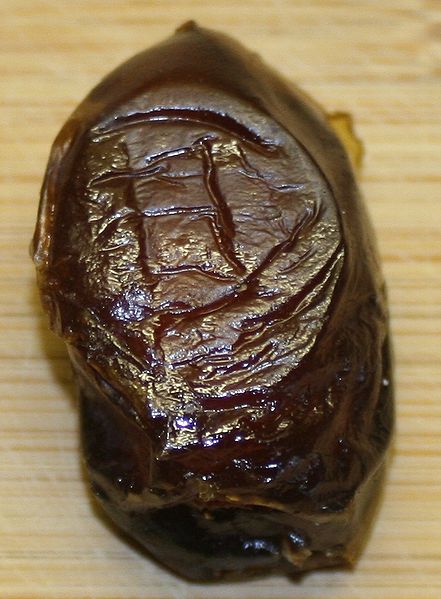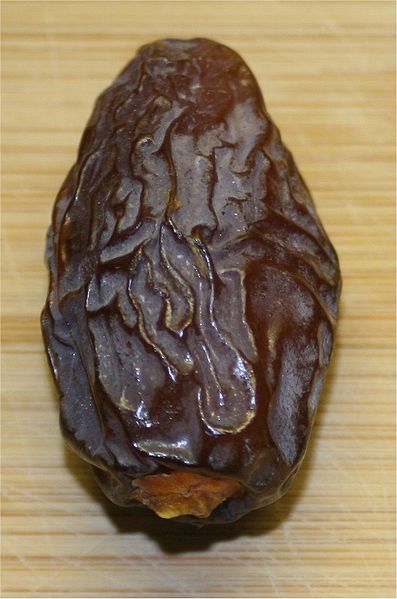What are the Benefits of Dates (Date Palm)
Where did Date Palm Originate
This is another of those plants that has been used for so long as a food source that it's beginnings are difficult to trace. Certainly it has been grown, died off, and regrown in the Persian Gulf region of the world.
The date palm has been cultivated for food for thousands of years, possible as far back as 4,000 BCE. It may have been grown in Arabia as long ago as 6,000 BCE.
Ancient Egyptians used the fruit for out-of-hand eating as well for the making of date wine.
Arab traders spread the date palm as far as Northern Africa, Spain and Italy. They were also cultivated in Asia and later, by Spanish Missionaries into Mexico and California around the late 1700s.
It can be found growing in a single tree or a clump of trees sharing the same root system. It is between thirty (30) and fifty (50) feet tall with a crown of leaves at the top that grow from six (6) to ten (10) feet long.
The word Date comes from the ancient Greek for finger (dáktulos) possibly in reference to it's shape.
Genetic research of the date, by finding the largest gene pool from a particular population, and working to smaller and smaller families indicate that the plant may well have started somewhere in present day Iraq.
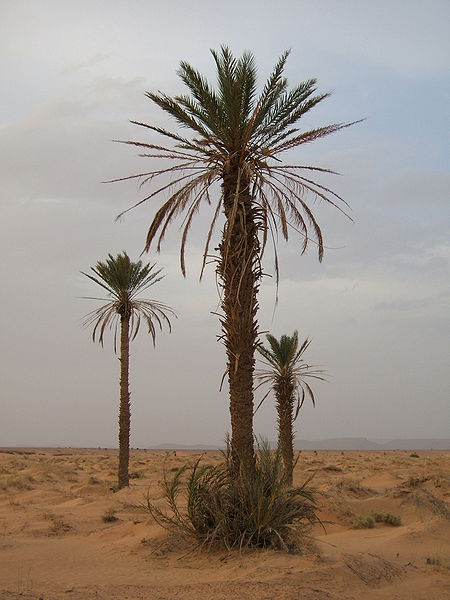
Date as Food
There are three main cultivating categories of date and thousands of cultivars.
Three main cultivars are:
- Soft (Barhee, Halawy, Khadrawy, Medjool)
- Semi-dry (Dayri, Deglet Noor, Zahidi)
- Dry (Thoory)
The types of fruit above basically depend on how much sugar each fruit contains.
As a food, three point five (3.5) ounces of date provide two thousand eight hundred (2,800) calories, with seventy five (75) grams of carbohydrate, sixty-three (63g) grams of sugars, eight (8g) grams fiber, less than half a gram (0.4g) of fat, two point five (2.5g) grams of protein, twenty-one (21g) grams of water, less than half a gram (0.4g) of vitamin C (less when completely dried), and point two six milligrams (0.262 mg) of manganese. Dates also contain trace amounts of potassium, boron, cobalt, copper, fluorine, magnesium, manganese, selenium, and zinc.
Dates are also high in antioxidants with the Deglet Noor variety being the best at scavenging free radicals.
Dates can be eaten fresh or dried, directly from hand to mouth, stuffed with nuts and dried fruit, or as an ingredient in puddings, baked goods, and juices.
The pit or seed of the date can also be dried and ground up and mixed with flour to make date breads during times of famine. Ground date seed has also been used as a replacement for ground coffee or as an adjunct to coffee.
Date palm sap is also used, by heating and driving off excess moisture, as a syrup,
Top Date Producing Countries
| Production (tons)
|
|---|---|
Egypt
| 1,313,069,000
|
Iran
| 1,000,000
|
Saudi Arabia
| 982,540
|
United Arab Emirates
| 755,000
|
Pakistan
| 557,520
|
Algeria
| 526,920
|
Iraq
| 440,000
|
Sudan
| 332,000
|
Oman
| 255,000
|
Libya
| 175,000
|


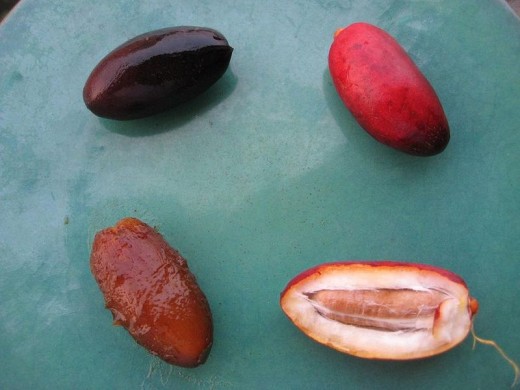
Other Uses
Animal Feed: Dried dates can also be used to feed camel, horse and dog. The date pit can also be ground up and used as an augmentation to fodder.
Beauty Aid: The date seed oil can be used to make both soap and cosmetics.
Silver Smithing: Carbonized date seed can be used as a charcoal replacement for silver smithing.
Date Palm Leaves
Date palm leaves are widely used as roofing material in Africa. Woven or twined the leaves can be used to make mats and rope. Leaves can also be crafted into fans and screens. It has also been used to make hats.
Building Material: Date palm trunks are used as both posts and rafters in home construction though the wood is not as strong as coconut.
Traditional Medicine
Dried dates are high in tanin and have been used as both an astringent and for intestinal troubles. As an infusion date juice is used for sore throat, colds, and bronchial conditions as well as a fever reducer.
Some believe date also reduces alcohol intoxication and there are some forms of beer made in the Persian Gulf that include date juice as an ingredient.
In India the sap gum from a wounded palm is used in the treatment for gastric distress and diarrhea as well as urinary tract infections.
The dried and ground roots are used for toothache.
Date pollen is thought to yield an estrogenic mimic.
Religious Significance
Both Christian and Judaic ceremonies include the use of date palm leaves. Palm Sunday, a Christian observance, includes the use date palm leaves and
The Jewish Feast of the Tabernacles includes the carrying of the Lulav (palm leaf) wrapped around myrtle, willow, and citron.
In Islam the date palm is mentioned in the Koran in at least seventeen (17) chapters. More than any other religious work.
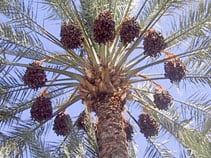
Harvesting and Processing
Date Palms reach maturity in three to five years with best harvest starting at ten to twelve years. The plant is both male female with only the female half producing fruit. Date palm live about one hundred fifty (150) years.
Because dates grow in clusters and the dates do not all ripen at the same time multiple harvests must be performed on a single cluster. Harvesting is a largely manual (and dangerous) process.
Date fruits are not the consistent brown that Westerners are so familiar with. They vary in size and shape as well as color. The fruit has a very thin skin with soft pulpy flesh surrounding a hard pit.
Unripe dates are can be green, ripening to yellow, and finally a dark reddish-brown completely ripe.
Kalai (Green) Stage
Fresh dates are the first harvested (called the Khalal stage) in the season with a low tannin level (see fresh date picture above), they must be only slightly astringent (if at all), and be sweet with no trace of bitterness. The Barhee, Zaghlool, Hayany and Khalas varieties are the best for fresh fruit with the Zaghlool, Hayany and Khalas varieties being sold locally. Only the Barhee variety is sold for export primarily to England, France and Australia.
Rutab (Ripe) Stage
This is the stage of harvest most Westerners are familiar with. It is the season of harvest with the greatest economic return as this particular stage produces the Medjool and and Deglet Nour.
Problems with this stage include a very short production period in a short period of time, dates in this stage are highly perishable and must be handled very carefully to prevent damage and spoilage.
The Deglet Nour variety is harvested mainly in Algeria, Israel, Tunisia and the USA, with most of the US production slated for export.
Tamar (Dried) Stage
This is fruit that has been allowed to dry on the palms. The varieties Dayri, Halawy, Khadrawy, Thoori, Zahidi, Sayer and Aliig are all harvested at this stage.
Because they are dried on the palm they are not as subject to spoilage of rot. Most Tamar stage dates are consumed in the country of production.
Usual and Less than Usual Date Recipes
Date Nut Bread
This is a recipe from the program The Barefoot Contessa. Its pretty standard as recipes go.
Ingredients
- 2 cups coarsely chopped dates (10 ounces pitted)
- 1/3 cup orange liqueur (recommended: Cointreau or Triple Sec)
- 4 tablespoons (1/2 stick) unsalted butter, at room temperature
- 3/4 cup light brown sugar, lightly packed
- 1 extra-large egg
- 1 teaspoon pure vanilla extract
- 1 tablespoon grated orange zest (2 oranges)
- 2 cups all-purpose flour
- 2 teaspoons baking powder
- 1/2 teaspoon baking soda
- 1 teaspoon ground cinnamon
- 1 teaspoon ground nutmeg
- 1/4 teaspoon ground cloves
- 1 teaspoon kosher salt
- 3/4 cup freshly squeezed orange juice (3 oranges)
- 3/4 cup coarsely chopped pecans (3 ounces)
Directions
You'll need need two medium sized bowls, a stand or hand mixer, measuring cups and spoons, and a bread pan.
- Preheat the oven to 350° F.
- Using shortening or butter the bottom of a loaf pan and line the bottom of the pan with parchment paper, then butter and flour the pan.
- Flouring the pan is pretty simple. After adding the butter or shortening put two tablespoons of flour in the pan and shake the pan around until the flour lightly coats the pan on the bottom and all sides.
- Combine the dates and orange liqueur in a small bowl and set aside for 30 minutes. This will slightly rehydrate the date pieces and also add a bit of acid to prevent oxidation of the dates.
- In the bowl of an electric mixer, beat the butter and brown sugar together on medium speed for one (1) minute then scrape down the bowl. With the mixer on low, add the egg, vanilla, and orange zest.
- In the second bowl sift together the flour, baking powder, baking soda, cinnamon, nutmeg, cloves, and salt.
- With the mixer still on low, add the flour mixture alternately with the orange juice to the creamed mixture, beating only until combined.
- With a spatula or spoon, stir in the dates with their liquid, and the pecans.
- Pour the batter into the prepared loaf pan and smooth the top.
- Bake for fifty minutes to an hour (50 to 60), until a toothpick comes out clean.
- Cool in the pan for 10 minutes, then turn out onto a wire rack and cool completely.
Optional Cream Cheese Topping
- In the bowl cream the cream cheese, sugar, and orange zest on medium speed until just combined.
- Slice the bread and serve with the orange cream cheese on the side for spreading.
Date Nut Squares (by Diana Rattray)
You will need a medium saucepan and a cookie sheet for this recipe.
Ingredients
- 2 1/2 cups sugar
- 1/4 teaspoon salt
- 1 cup evaporated milk
- 2 cups chopped pecans, hazelnuts, or walnuts
- 1 1/2 cups finely chopped dates
- 1 teaspoon vanilla extract
Directions
- In a heavy saucepan, combine sugar, salt, and evaporated milk.
- Bring to a boil, stirring, until sugar is dissolved.
- Cook, stirring occasionally, until mixture reaches soft ball stage* or to 236° F on candy thermometer.
- Remove from heat and add remaining ingredients.
- Let stand until lukewarm, then beat with a wooden spoon until mixture is creamy and loses its gloss.
- Spread mixture in a 9-inch square pan and let stand until firm.
- Cut into squares. (makes about 2 pounds of candy).
Date Shake
All that's required for this is a blender.
- 3/4 Cup Medjool or Deglet Noor dates
- 1 1/4 Cup milk
- 1 Pint Vanilla Ice Cream
Directions
- Blend dates and 1/2 cup of milk at high speed until smooth.
- Add remaining milk and ice cream, blending at low speed until mixed.
- Serve immediately.
Disclaimer
The author was not compensated by any mentioned manufacturer for the writing of this article. The author was not compensated with cash, discounts, or freebies for the writing of this article or any of its content.
The author does stand to make a small percentage of profits on both the article for word count (loosely) and any advertising; however, the author has no control over that advertising or content of that advertising.

